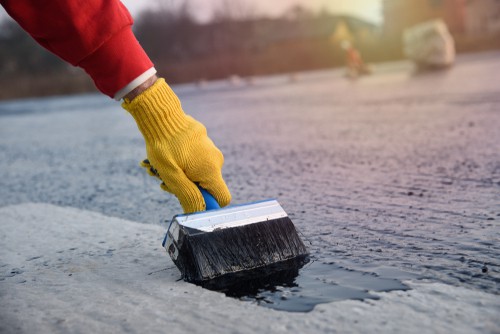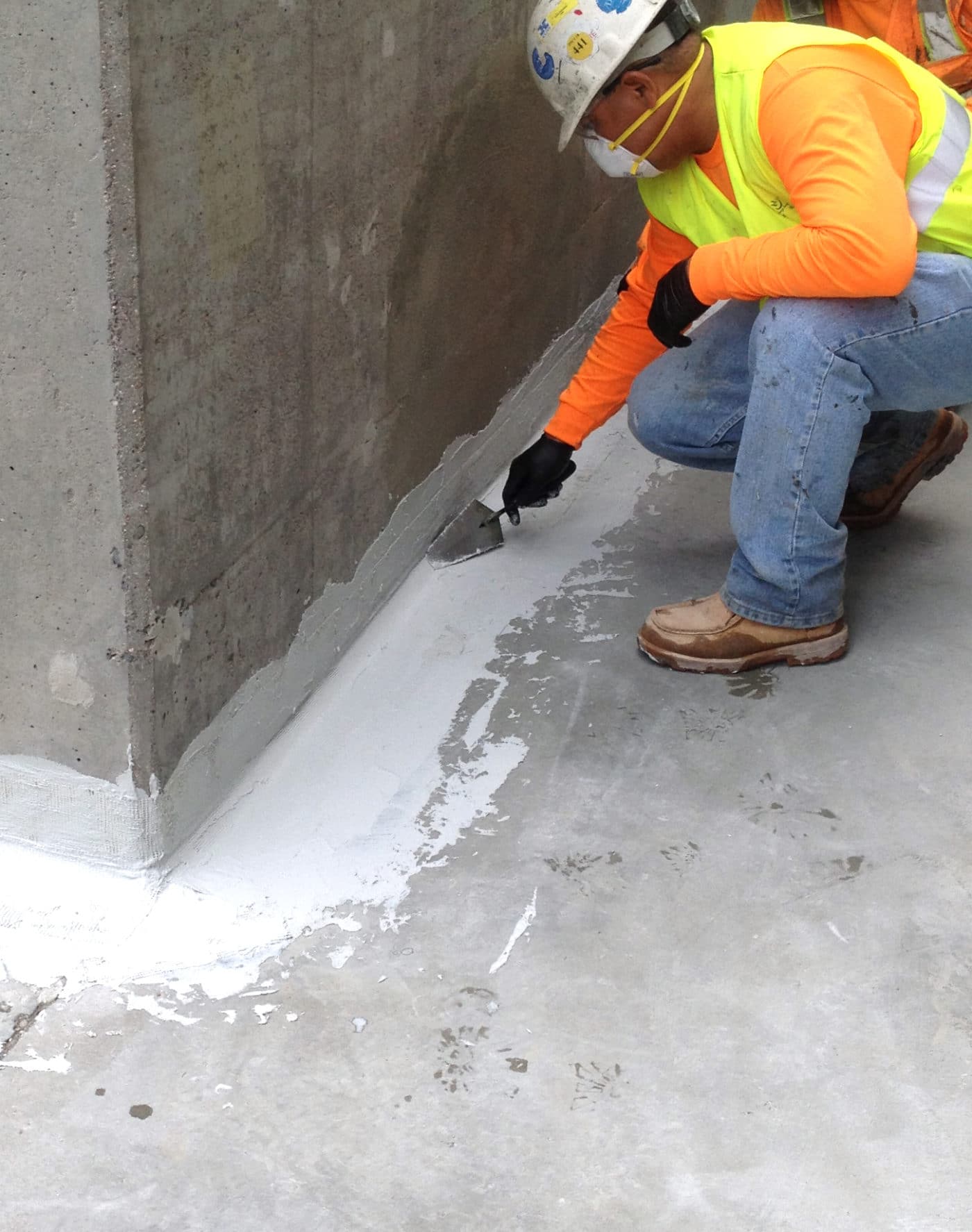Why Waterproofing Is Critical for Durable Frameworks: a Thorough Evaluation
Waterproofing plays a vital role in the longevity of structures. It functions as an obstacle versus wetness, which can cause substantial issues like mold and mildew and damage. Comprehending the various waterproofing approaches and their ramifications is essential for property proprietors. The repercussions of overlooking this element can be serious. Checking out these aspects exposes not simply the need of waterproofing, yet likewise its broader influence on building value and safety and security.
Recognizing Waterproofing: Interpretation and Value
Waterproofing acts as a crucial barrier versus moisture invasion, safeguarding structures from prospective damages. It encompasses different approaches and materials developed to stop water penetration into buildings, making sure longevity and functionality. The value of waterproofing can not be overemphasized, as it secures against a series of problems, consisting of mold and mildew development, wear and tear of materials, and structural weakening.Effective waterproofing services can include membrane layers, coatings, and sealants, each tailored to particular atmospheres and architectural styles. By developing a safety layer, these remedies aid keep a completely dry inside, which is crucial for the health of residents and the conservation of property value.Moreover, purchasing waterproofing at the building stage is substantially extra cost-effective than addressing water-related issues after they occur. Comprehending the concepts of waterproofing is vital for designers, builders, and property owners intending for sturdy, resistant structures that hold up against the examination of time and ecological challenges.

The Influence of Water Damages on Structural Integrity
Water damages presents significant threats to architectural integrity, mainly with the growth of mold and mold. These organisms not only compromise indoor air high quality however likewise cause product destruction gradually. In addition, long term direct exposure to wetness can deteriorate architectural elements, enhancing the possibility of collapse or failure.
Mold and Mildew Development
Dampness breach presents a substantial hazard to the architectural stability of buildings, resulting in the proliferation of mold and mildew. These fungi thrive in wet settings, usually taking origin in concealed areas such as wall dental caries, under floor covering, and in ceilings. Their growth not just produces unattractive stains and undesirable smells however likewise adds to a decrease in interior air quality, presenting wellness threats to owners. Mold and mildew can jeopardize materials like wood and drywall, resulting in additional moisture retention and producing a cycle of damages. Early discovery and remediation are necessary to prevent extensive development, highlighting the necessity of effective waterproofing procedures. Dealing with moisture problems promptly can shield both the health and wellness of residents and the long life of the structure.
Structural Weakening Threats
Unrestrained dampness invasion can bring about serious architectural weakening, jeopardizing the honesty of buildings. Water damages often impacts fundamental elements, such as light beams, columns, and walls, leading to compromised load-bearing capability. Long term exposure to wetness can cause products like wood to rot and steel to wear away, compromising their structural homes. This degeneration might lead to fractures, bowing, or perhaps devastating failings if left unaddressed. Yard drainage Omaha. Additionally, water infiltration can threaten the dirt under structures, causing settling or moving that further intensifies architectural dangers. Consequently, carrying out effective waterproofing solutions is vital in protecting a building's structural honesty, protecting against pricey fixings, and ensuring safety and security for passengers. Correct maintenance and aggressive measures are vital in alleviating these significant threats related to water damage
Kinds of Waterproofing Methods and Products
Waterproofing approaches and products play an essential duty in securing structures from water damage. Key strategies consist of membrane waterproofing, which provides a physical obstacle; liquid waterproofing services that form a smooth coat; and cementitious waterproofing options recognized for their longevity and simplicity of application. Comprehending these numerous strategies is crucial for picking the most suitable method for details building and construction requirements.
Membrane Waterproofing Strategies
Membrane layer waterproofing strategies are essential for shielding frameworks from the damaging effects of water seepage. These techniques entail the application of water resistant membrane layers that produce a barrier against dampness. Both primary types of membrane layer systems are sheet membranes and liquid-applied membrane layers. Sheet membranes, normally made from products such as rubberized asphalt or thermoplastic, are built and can be rolled out and stuck to surfaces. In contrast, liquid-applied membrane layers are applied as a fluid and cure to create a smooth layer. Both types provide versatility and resilience, dealing with various applications, consisting of roofs, basements, and structures. Proper installment and maintenance of these membrane layers assure long-lasting defense, enhancing the life expectancy and honesty of the structures they secure.
Fluid Waterproofing Solutions
Fluid waterproofing solutions stand for a functional choice to traditional membrane systems. These solutions typically involve the application of liquid finishings that treat to form a seamless, sturdy barrier versus water infiltration. Numerous kinds of liquid waterproofing products are readily available, including polyurethane, asphalt, and acrylic-based formulas. Each kind provides distinct buildings, such as flexibility, bond, and UV resistance, making them appropriate for diverse applications. The application process commonly entails spraying or rolling the fluid onto surfaces, enabling insurance coverage of complex shapes and details, which reduces possible powerlessness. Liquid waterproofing remedies are especially beneficial for locations with motion, such as joints and splits, as they can suit architectural shifts without jeopardizing integrity, making certain long-lasting defense for structures.
Cementitious Waterproofing Options
Countless cementitious waterproofing alternatives are readily available, offering reliable options for various building and construction requirements. These systems typically contain a blend of concrete, sand, and additives, making them ideal for both exterior and interior applications. Among the prominent selections are crystalline waterproofing products, which react with dampness to form a water resistant obstacle within the concrete matrix. In addition, discover this info here flexible cementitious finishings provide improved flexibility, suiting minor structural motions without endangering the waterproofing integrity. It is likewise common to use cementitious sealers for joints and cracks, guaranteeing detailed protection against water infiltration. On the whole, cementitious waterproofing options are valued for their longevity, ease of application, and compatibility with different substratums, making them a favored selection in modern building techniques.
Long-Term Cost Savings With Reliable Waterproofing
Investing in efficient waterproofing options can greatly reduce long-lasting expenses for structure proprietors and programmers. By preventing water intrusion, these solutions reduce damage to structural aspects, reducing the need for pricey repairs and upkeep with time. Waterproofing additionally secures indoor surfaces and furnishings, reducing substitute expenses and improving the total life-span of the property.Moreover, reliable waterproofing can lead to energy cost savings by enhancing insulation and lowering humidity-related issues. This leads to lower heating & cooling expenditures, adding to an extra sustainable financial design for home management.Additionally, the execution of waterproofing steps can improve residential property value by making certain a completely dry, safe, and resilient environment. While the preliminary financial investment in waterproofing may appear substantial, the lasting economic benefits much exceed the ahead of time expenses, making it a sensible decision for anyone entailed in construction or home monitoring.

The Function of Waterproofing in Building Ordinance and Rules
Waterproofing plays a significant function in structure codes and policies, mirroring its importance in modern building and construction methods. These codes are created to ensure safety, durability, and sustainability in buildings, stressing the requirement for reliable waterproofing procedures. Numerous nationwide and local structure codes lay out particular needs for waterproofing products and methods, especially in areas vulnerable to water breach, such as cellars and foundations.Compliance with these regulations not only secures structures from moisture-related damages but additionally safeguards public health and wellness by preventing mold and mildew growth and architectural instability. Inspectors usually examine waterproofing aspects throughout the building procedure to guarantee adherence to established standards. As environment change raises the frequency of extreme weather condition events, the role of waterproofing in building ordinance is anticipated to develop, possibly causing stricter laws. Generally, the integration of waterproofing in governing frameworks emphasizes its essential role in attaining lasting, resistant frameworks.
Instance Studies: Effective Waterproofing Solutions
Successful waterproofing options have been carried out across different tasks, showcasing ingenious strategies that enhance architectural integrity and durability. One remarkable example is the improvement of the historic Smith Tower in Seattle, where sophisticated membrane systems were used to safeguard the framework from water breach. This method not only maintained the building's aesthetic however additionally extended its lifespan.In one more instance, a big industrial structure in Miami used crystalline waterproofing modern technology, which responds with dampness to form a barrier versus water. This remedy showed efficient against the city's high moisture and heavy rainfall.Additionally, a bridge in San Francisco undertook a substantial waterproofing therapy making use of epoxy finishes, which greatly decreased upkeep costs and boosted toughness. These situation research studies show the performance of tailored waterproofing approaches in diverse atmospheres, underscoring the value of selecting proper techniques to attend to certain obstacles and assure the durability of structures.
Finest Practices for Implementing Waterproofing Methods
Carrying out efficient waterproofing techniques calls for mindful planning and adherence to best practices try this - Sump pump installation & replacement Omaha. First, it is vital to perform a comprehensive website assessment to recognize potential locations of water ingress. This assessment notifies the option of suitable products and techniques tailored to particular ecological conditions. Using high-quality, long lasting waterproofing membrane layers can considerably improve defense against moisture.Additionally, appropriate installment techniques are essential; guaranteeing that surfaces are tidy and devoid of pollutants promotes suitable adhesion. Regular upkeep checks ought to be set up to identify any kind of indicators of wear or damage, enabling timely repairs.Moreover, incorporating drainage systems can properly manage water overflow, preventing build-up around frameworks. Educating all employees associated with building concerning waterproofing needs more warranties uniformity and adherence to ideal techniques. Ultimately, a proactive approach to waterproofing can significantly prolong the life expectancy of structures and minimize long-lasting maintenance expenses
Often Asked Concerns
How Does Waterproofing Affect Energy Effectiveness in Structures?
Waterproofing greatly ditra waterproofing enhances energy effectiveness in buildings by stopping dampness breach. This reduces the need for heating & cooling, preserves constant interior temperature levels, and inevitably decreases energy consumption, contributing to long-term sustainability and price savings.
Can Waterproofing Be Applied to Existing Frameworks?
Waterproofing can certainly be applied to existing structures. Various approaches, such as membranes, coatings, and sealants, enable property proprietors to boost security against dampness, consequently extending the structure's integrity and decreasing possible damages over time.
What Are the Indications of Inadequate Waterproofing?
Indicators of insufficient waterproofing consist of water discolorations on walls, mold and mildew development, peeling off paint, musty odors, and wetness in basements - Water Solutions Omaha. These indications suggest potential architectural damage and the need for instant focus to avoid more damage
How Usually Should Waterproofing Be Examined or Kept?
Waterproofing must be inspected at the very least each year, particularly in areas with hefty rains or changing temperature levels. Normal maintenance guarantees early discovery of issues, promoting structural honesty and lengthening the lifespan of the building.
Are There Eco-Friendly Waterproofing Options Available?
Green waterproofing options are progressively readily available, making use of sustainable materials such as bio-based polymers and natural sealers. These options not only safeguard structures however likewise minimize environmental influence, appealing to eco mindful building contractors and residential property proprietors.